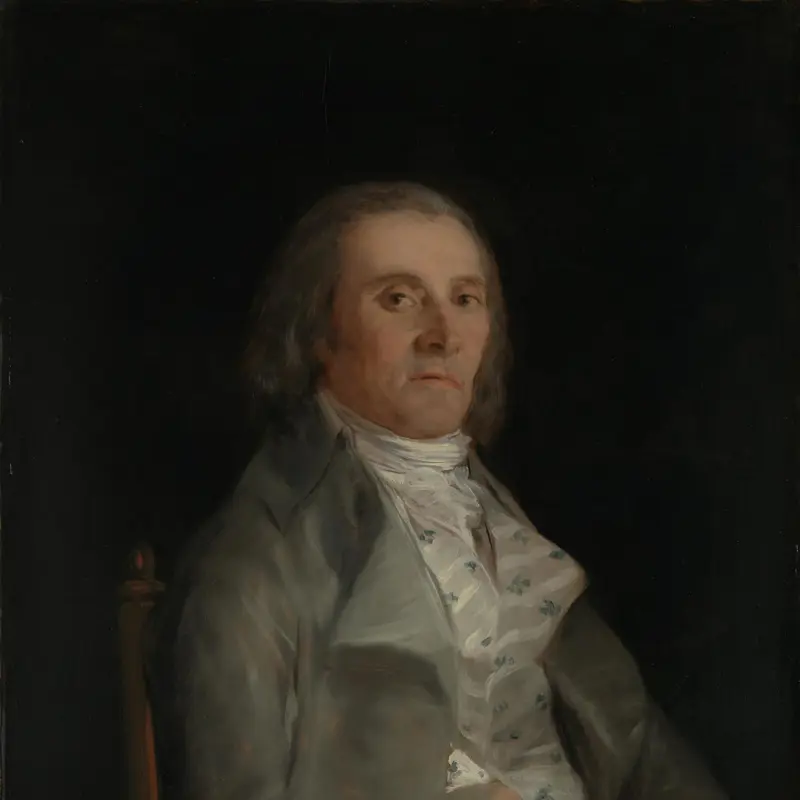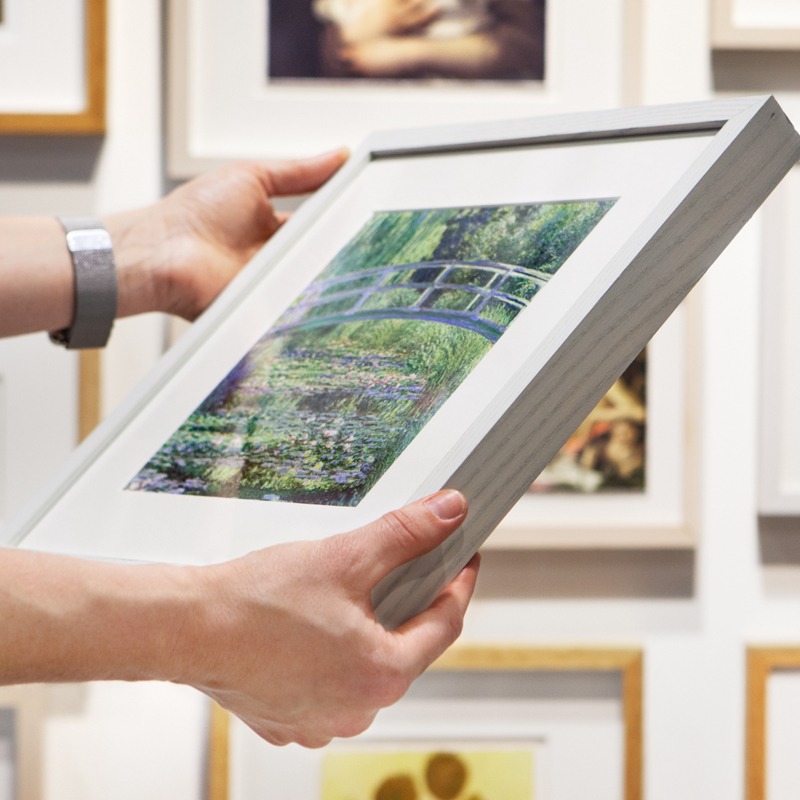Francisco de Goya, 'The Duke of Wellington', 1812-14
About the work
Overview
This portrait of Arthur Wellesley, 1st Duke of Wellington, was painted after he had defeated the French forces of Napoleon and entered Madrid victorious in August 1812.
Wellington sat for Goya shortly after his arrival in Madrid, and the artist produced a large painting of the Duke on horseback (Apsley House, London), a drawing (British Museum, London) and our painting on panel. Although this portrait was probably painted directly from life, Goya later altered Wellington’s pose and made significant changes to the composition as the Duke was awarded the different medals and military orders he wears here.
Wellington was a short man, and Goya paints him in an upright pose with his head held high, as if wishing to appear taller. The composition’s simplicity focuses our attention on Wellington’s face. This is not the look of a triumphant man: his face is gaunt and exhausted from battle, contrasting with the bright crimson military uniform he wears.
Key facts
Details
- Full title
- The Duke of Wellington
- Artist
- Francisco de Goya
- Artist dates
- 1746 - 1828
- Date made
- 1812-14
- Medium and support
- oil on wood
- Dimensions
- 64.3 × 52.4 cm
- Acquisition credit
- Bought with aid from the Wolfson Foundation and a special Exchequer grant, 1961
- Inventory number
- NG6322
- Location
- Room 38
- Collection
- Main Collection
- Frame
- 18th-century French Frame
Provenance
Additional information
Text extracted from the ‘Provenance’ section of the catalogue entry in Neil MacLaren, revised by Allan Braham, ‘National Gallery Catalogues: The Spanish School’, London 1988; for further information, see the full catalogue entry.
Exhibition history
-
2009The Discovery of Spain: British Artists and Collectors, Goya to PicassoNational Gallery of Scotland18 July 2009 - 11 October 2009Museo de Bellas Artes de Sevilla1 October 2009 - 31 December 2009
-
2015Wellington: Triumphs, Politics and PassionsNational Portrait Gallery (London)12 March 2015 - 7 June 2015
-
2015Goya: The PortraitsThe National Gallery (London)7 October 2015 - 10 January 2016
-
2020Masterpieces from the National Gallery, LondonThe National Museum of Western Art18 June 2020 - 18 October 2020The National Museum of Art3 November 2020 - 31 January 2021
-
2021Botticelli to Van Gogh: Masterpieces from the National Gallery, LondonNational Gallery of Australia5 March 2021 - 14 June 2021
Bibliography
-
1909A Catalogue of the Pictures and Drawings in the National Loan Exhibition, in Aid of the National Gallery Funds, held in the Grafton Galleries, London 1909
-
1922A. de Beruete, Goya as Portrait Painter, London 1922
-
1935G. Wellesley and 7th Duke of Wellington and J. Steegmann, The Iconography of the First Duke of Wellington, London 1935
-
1958J.A. Gaya Nuño, La pintura española fuera de España: Historia y catálogo, Madrid 1958
-
1961P. Troutman et al., Goya and his Times (exh. cat. Royal Academy of Arts, Winter 1963), London 1961
-
1962The National Gallery, The National Gallery: January 1960 - May 1962, London 1962
-
1962M. Webster, 'Crónica de Londres', Goya, 46, 1962, pp. 303-7
-
1964E. du G. Trapier, Goya and His Sitters: A Study of His Style as a Portraitist, New York 1964
-
1964N. Glendinning, 'Goya and England in the Nineteenth Century', The Burlington Magazine, CVI/730, 1964, pp. 4-14
-
1966A. Braham, 'Goya's Equestrian Portrait of the Duke of Wellington', The Burlington Magazine, CVIII/765, 1966, pp. 618-21
-
1966A. Braham, 'Goya's Portrait of the Duke of Wellington in the National Gallery', The Burlington Magazine, CVIII/755, 1966, pp. 78-83
-
1967'Editorial: Thefts from Museums', The Burlington Magazine, CIX/767, 1967, pp. 55-6
-
1970N. MacLaren and A. Braham, The Spanish School, 2nd edn, London 1970
-
1971P. Gassier and J. Wilson-Bareau, Goya: His Life and Work, with a Catalogue Raisonné of the Paintings, Drawings and Engravings, London 1971
-
1971J. Gudiol, Goya, 1746-1828: Biography, Analytical Study and Catalogue of His Paintings, trans. K. Lyons, Barcelona 1971
-
1981J. Camón Aznar, Francisco de Goya, Zaragoza 1981
-
1981A. Braham, El Greco to Goya: The Taste for Spanish Paintings in Britain and Ireland (exh. cat. The National Gallery, 16 September - 9 November 1981), London 1981
-
1983P. Gassier, Francisco de Goya, Würzburg 1983
-
1983M. Helston, Spanish and Later Italian Paintings, London 1983
-
1988Maclaren, Neil, revised by Allan Braham, National Gallery Catalogues: The Spanish School, 2nd edn (revised), London 1988
-
1988A. Braham, 'Wellington y Goya', in La alianza de dos monarquías: Wellington en España, Madrid 1988, pp. 144-63
-
1992J. Baticle, Goya, Paris 1992
-
2001
C. Baker and T. Henry, The National Gallery: Complete Illustrated Catalogue, London 2001
-
2004S. Symmons, '"A New People and a Limited Society": British Art and the Spanish Spectator', in C. Payne (ed.), English Accents: Interactions with British art c. 1776-1855, Aldershot 2004, pp. 101-24
-
2008G. Dufour, Goya durante la Guerra de la Independencia, Madrid 2008
-
2008M.B. Mena Marqués et al., Goya en tiempos de Guerra (exh. cat. Prado, 4 April - 13 July 2008), Madrid 2008
-
2009C. Baker, D. Howarth and P. Stirton, The Discovery of Spain: British Artists and Collectors (exh. cat., Royal Scottish Academy, Edinburgh), Edinburgh 2009
-
2009D. Carr, El Greco to Goya: Spanish Painting, London 2009
About this record
If you know more about this work or have spotted an error, please contact us. Please note that exhibition histories are listed from 2009 onwards. Bibliographies may not be complete; more comprehensive information is available in the National Gallery Library.






